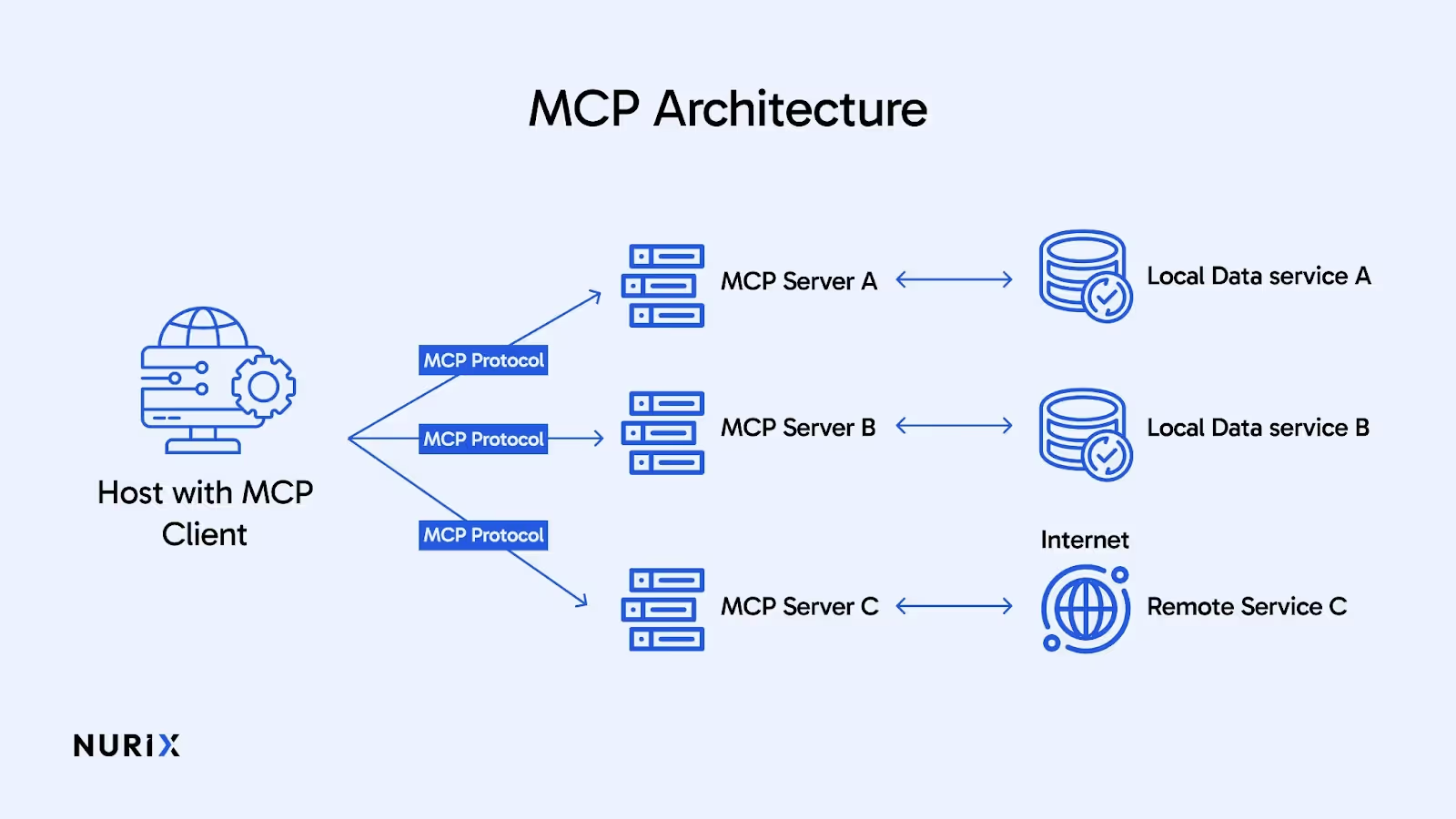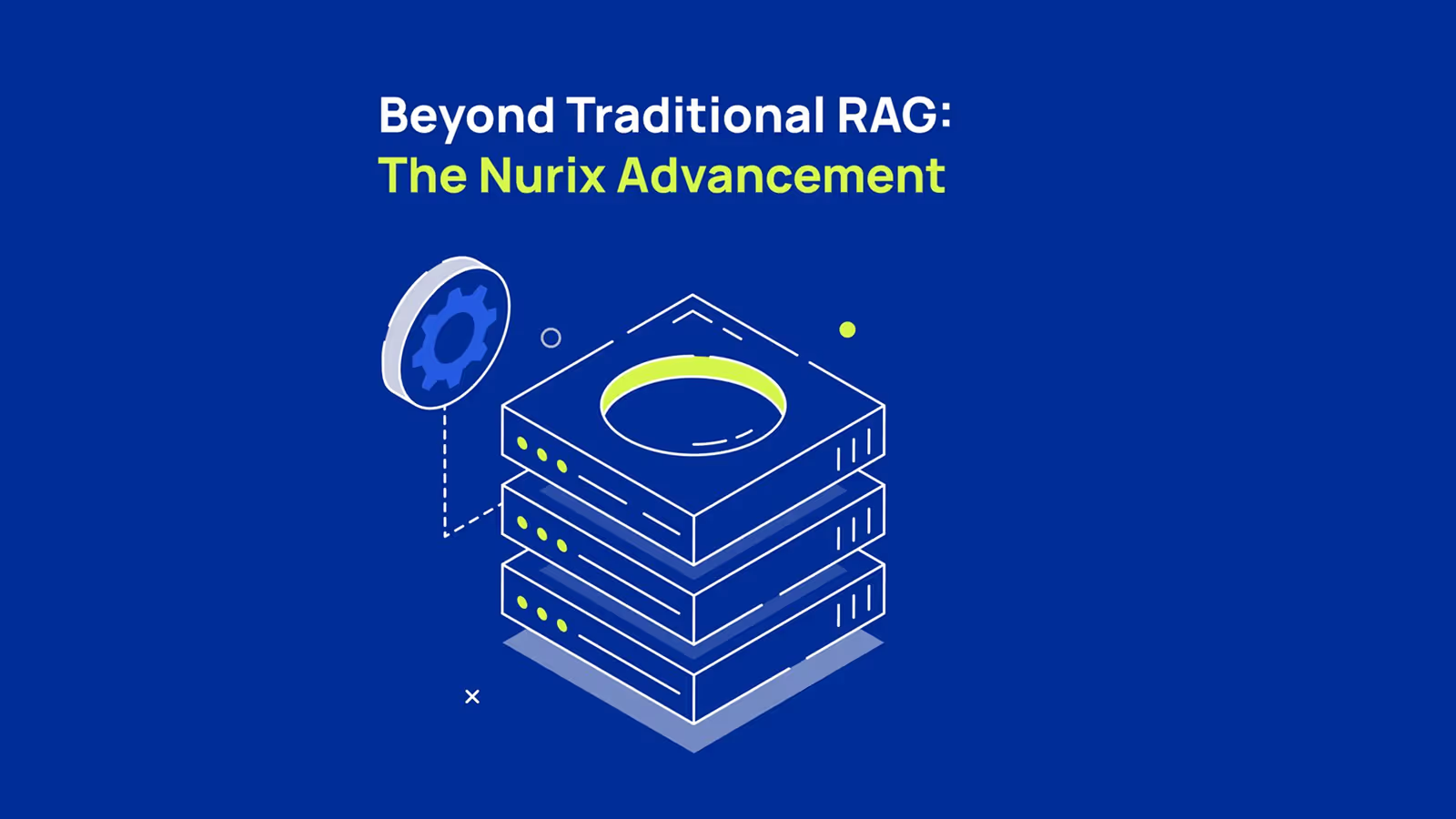AI agents are evolving, but there’s a fundamental problem: they’re disconnected from the very data and tools businesses rely on to make decisions. As the AI agents market is projected to grow from USD 7.84 billion in 2025 to USD 52.62 billion by 2030, the question remains: how can businesses ensure their AI systems don’t just sit idly, but actively engage with the real world?
The gap between AI models and real-time, dynamic data is costing businesses the full potential of AI. That’s where MCP in AI steps in, creating a bridge between AI agents and external data sources, tools, and services. It’s the catalyst that turns AI from a passive tool into an active participant in your business.
In this blog, we’ll explore how MCP isn’t just changing AI, it’s transforming the way businesses interact with technology, driving real-time intelligence, smooth automation, and unprecedented opportunities.
What is MCP?
The Model Context Protocol (MCP) is an open standard developed by Anthropic designed to facilitate two-way communication between AI models and external systems. This protocol allows AI agents to access and interact with various tools and data sources, making them much more versatile and effective in performing tasks across diverse platforms.
In simple terms, MCP in AI provides a framework that allows AI agents to act as more than just standalone models. They can now interact dynamically with the world, performing tasks like querying databases, utilizing APIs, or even triggering actions in other software systems, all within a secure and structured environment.
Key Components of MCP in AI

To understand how MCP in AI works, it's essential to explore its core components:
- Host Application: The central AI-powered app users interact with (e.g., Claude Desktop, IDEs, LLM chat interfaces). It manages system operations, LLM interactions, context aggregation, and user authorization.
- MCP Client: Acts as an intermediary between the host and MCP servers, routing messages, managing protocol negotiation, and ensuring security.
MCP Server: Exposes tools, data, or services (e.g., GitHub, Slack) to AI models via standardized interfaces. Servers provide specialized resources for AI consumption. - Transport Layer: Utilizes STDIO for local integrations and HTTP + SSE for remote connections, enabling both requests and streaming responses.
- Base Protocol: Based on JSON-RPC 2.0, this protocol defines the structure for requests, responses, and notifications, and manages session control and capability negotiation.
- Server and Client Features: Servers offer resources and tools, while clients handle functionalities like sampling and directory listings.
- Utilities: Provide essential support like logging and argument completion, ensuring smooth protocol operation.
While understanding what MCP in AI is, laying the foundation, the real question is: how does it elevate AI beyond its static boundaries to drive real-world impact? Let’s look at how MCP enhances the performance of AI agents in truly transformative ways.
How MCP Enhances AI Agent Performance
The Model Context Protocol (MCP) significantly boosts AI agent performance by improving how models interact with real-time data and tools. Here’s how MCP drives these enhancements:
- Real-Time, Contextual Data Access: AI agents can access live, organization-specific data from various sources (e.g., CRMs, databases), ensuring responses are accurate and contextually relevant.
- Enhanced Contextual Understanding: Standardizing interactions with external systems, MCP in AI gives models deeper context, improving the quality of outputs, especially in complex workflows.
- Reduced Redundancy and Improved Efficiency: By managing state and minimizing redundant data processing, MCP streamlines development and inference, making AI more efficient.
- Smooth Multi-Tool Integration: MCP’s universal protocol eliminates the need for custom connectors, enabling faster integration of new tools and data sources, scaling AI agents quickly.
- Smoother Context Switching: MCP in AI reduces performance drops when switching tasks by offering a unified interface, ensuring more consistent behavior across different systems.
- Agentic Capabilities and Automation: MCP allows AI agents to take actions like updating records or triggering workflows, transforming them from passive responders to proactive assistants.
- Security, Privacy, and User Control: With robust authorization flows and permissions, MCP ensures secure, transparent data access, building trust in sensitive environments.
After examining how MCP enhances AI performance, the next step is understanding how it’s woven into the very architecture of AI agents, enabling them to function at their full potential.
MCP in AI Agent Architecture
The Model Context Protocol (MCP) is a foundational technology in modern AI agent architecture, enabling smooth, secure, and scalable integration between AI agents and the diverse systems, data sources, and tools essential for enterprise workflows.
- Centralized Communication Layer: MCP acts as a universal interface that connects AI agents to external databases, cloud platforms, business applications, and internal tools through a standardized protocol. This eliminates the need for custom integrations for each new system, streamlining deployment and maintenance.
- Client-Server Model: The architecture is built around three main components:
- MCP Host: The AI-powered application or agent that users interact with.
- MCP Client: Manages communication, maintains state, and ensures secure data exchange between the host and external systems.
- MCP Server: Exposes specific resources or functionalities (such as file systems, search engines, or business apps) in a standardized way, making them accessible to the AI agent.
- Stateful, Context-Aware Operations: MCP supports multi-step, context-rich workflows, allowing AI agents to remember previous interactions, manage ongoing tasks, and coordinate actions across multiple systems. This enables more sophisticated automation and decision-making.
- Modularity and Extensibility: With MCP, new capabilities can be added by simply connecting additional servers, without altering the core AI agent logic. This modularity allows enterprises to quickly adapt to changing business needs and scale their AI solutions efficiently.
- Security and Access Control: MCP incorporates robust permissioning, user consent flows, and secure transport mechanisms, ensuring that AI agents interact with sensitive enterprise data in a controlled and compliant manner.
Having understood how MCP shapes the architecture of AI agents, let’s shift focus to how it’s changing AI coding, making development smoother, faster, and more scalable.
MCP in AI Coding
The Model Context Protocol (MCP) is transforming AI coding environments by providing a standardized, secure, and scalable way for AI models to interact with codebases, development tools, and external data sources. Here’s how MCP enhances AI coding workflows:
1. Smooth Integration with Development Tools
- MCP allows AI coding assistants to connect directly to code repositories, issue trackers, documentation, and other developer resources through pre-built or custom MCP servers.
- This integration means AI agents can access the latest code, project context, and relevant documentation in real time, enabling more accurate and context-aware code suggestions and reviews.
2. Context-Rich Code Assistance
- By maintaining stateful connections and sharing contextual information, MCP enables AI models to understand the broader context of a coding task, such as related files, recent changes, or open issues, leading to more nuanced and functional code generation.
- This reduces the number of attempts needed to produce working code and helps AI agents provide better explanations and code reviews.
3. Dynamic Tool Discovery and Workflow Automation
- MCP supports dynamic tool discovery, allowing AI coding agents to automatically detect and interact with new tools (like testing frameworks, CI/CD pipelines, or deployment scripts) without manual reconfiguration.
- This capability streamlines complex workflows, enabling agents to automate tasks such as running tests, deploying code, or updating documentation.
4. Security, Privacy, and User Control
- MCP enforces robust user consent, access controls, and clear authorization flows, ensuring that sensitive code and data are only accessed with explicit permission.
- Developers retain control over what information is shared and what actions the AI agent can perform, supporting safe integration within enterprise environments.
5. Developer-Friendly and Extensible
- With SDKs available in multiple languages (Python, TypeScript, Java, Kotlin, C#), MCP is accessible for a wide range of development stacks.
- Its modular, open-source architecture allows teams to easily extend capabilities or build custom integrations customized to their specific coding workflows.
With MCP transforming the way AI is coded, it's time to look at how these innovations translate into real-world applications, driving change across industries and unlocking new possibilities.
Real-World Applications of MCP
The Model Context Protocol (MCP) is being adopted across various industries to enable AI agents to securely and efficiently interact with business-critical data, tools, and workflows. Its standardized approach allows organizations to build more integrated, context-aware, and autonomous AI solutions. Here are some real-world applications and examples of companies taking advantage of MCP:
- AI-Powered Chatbots and Virtual Assistants: MCP enables chatbots to access up-to-date information from multiple business systems, improving customer support and internal helpdesk automation.
- Automated Workflow Orchestration: Enterprises use MCP to connect AI agents with project management, CRM, and file storage platforms, automating multi-step business processes.
- Healthcare Data Integration: MCP supports secure, context-rich access to patient records, enabling AI agents to assist with care coordination, predictive analytics, and compliance monitoring.
- Financial Services Automation: Banks and financial institutions use MCP to power AI agents for risk assessment, personalized customer engagement, and regulatory compliance.
- Intelligent Document Processing: Legal and research organizations employ MCP-enabled agents to process, summarize, and analyze large volumes of documents, extracting actionable insights and reducing manual workload.
Examples of Companies Using MCP
- Microsoft: Integrated MCP into Copilot Studio, enabling smooth connections between AI assistants and business data, apps, and systems. This allows for more accurate, context-rich responses and faster setup of AI-powered workflows in Microsoft 365 environments.
- AWS: Uses MCP in its Bedrock agents to streamline development and make AI more useful in day-to-day operations, connecting agents to a wide range of AWS services and enterprise data sources.
- GitHub: Employs MCP for its AI assistants, allowing them to access code, issues, and documentation directly, which enhances developer productivity and collaboration.
While real-world applications of MCP show its immediate impact, the future holds even greater potential as we envision how it could transform industries and drive the next wave of AI innovation.
Future Prospects of MCP
The Model Context Protocol (MCP) is set to become a foundational technology in AI integration, with several emerging trends and technologies shaping its future trajectory.
1. Expansion of Standardization and Ecosystem Growth
- MCP is rapidly evolving from a promising concept to an industry cornerstone, with more organizations adopting it as the "USB-C of AI", a universal interface for connecting models to real-world data and tools.
- The future will see a growing marketplace of plug-and-play MCP connectors, allowing businesses to integrate new tools and data sources with minimal effort.
2. Advanced Transport and Communication Layers
- Upcoming MCP implementations will expand support for remote servers via HTTP and other protocols, making it easier to connect distributed systems and cloud-based resources.
- Lightweight, efficient communication standards like JSON-RPC will continue to underpin MCP, ensuring low-latency and scalable interactions between AI agents and external services.
3. Dynamic Tool Discovery and Contextual Intelligence
- MCP will further enable dynamic tool discovery, allowing AI agents to automatically detect, describe, and use new tools or APIs as they become available, without manual configuration.
- Enhanced context-aware state management will empower AI to execute multi-step, complex workflows with a deeper understanding of user intent and business logic.
4. Security, Privacy, and Governance
- As MCP adoption grows, robust security and access control features will be critical. Expect continued advancements in authentication, user consent, and policy-driven governance to ensure safe and compliant AI operations.
- Lifecycle management and observability will become essential, enabling enterprises to monitor and audit AI interactions with sensitive data.
5. Interoperability and Extensibility
- MCP’s design will foster smooth interoperability between diverse AI models, platforms, and enterprise systems, reducing fragmentation and integration overhead.
- Extensibility will allow MCP to support emerging technologies, such as IoT devices, edge computing, and domain-specific AI agents, broadening its impact across industries.
6. AI-Native and Autonomous Platforms
- MCP will be a key enabler for the next generation of AI-native platforms, where intelligent agents move beyond passive assistance to proactive, autonomous decision-making and action.
- These platforms will be composable, adaptive, and secure by design, accelerating the shift toward intelligent automation in business and beyond.
7. Marketplace and Community-Driven Innovation
- The development of a robust ecosystem, including a marketplace for MCP connectors, open-source tooling, and community-driven standards, will accelerate MCP’s adoption and innovation.
- Collaboration among vendors, developers, and enterprises will be essential for maturing the protocol and ensuring its long-term success.
Conclusion
As AI continues to infiltrate every corner of business, the true value lies not in the intelligence of the models themselves but in their ability to connect, adapt, and respond to the world around them. The Model Context Protocol (MCP) is the key that unlocks this potential, transforming AI agents from isolated tools into integrated, real-time problem-solvers.
For businesses looking to stay ahead in this rapidly growing market, the question is no longer whether AI can perform tasks; it’s whether your AI can interact smoothly with the data, tools, and systems that define your operations. The future of AI is not just about innovation; it’s about connection. And with MCP in AI, that connection is within reach.
The real question is, will your business harness the power of MCP to drive the next wave of AI-driven transformation? The clock is ticking, and those who move fast will reap the rewards.
Discover the future of drug discovery with Nurix AI, where artificial intelligence meets precision to uncover groundbreaking therapies. Our platform redefines how you approach drug development, making complex problems simpler and faster to solve.
- Accelerate target identification with AI-powered insights
- Maximize discovery potential through scalable machine learning models
- Empower your team with real-time data integration and predictive capabilities
Ready to bring your next breakthrough to life? Start a Conversation with Nurix AI

.avif)





.avif)
.avif)


